IDFA 2020 Part 3: SHE HAD A DREAM, JACINTA, THE MOLE AGENT And SHOWGIRLS OF PAKISTAN
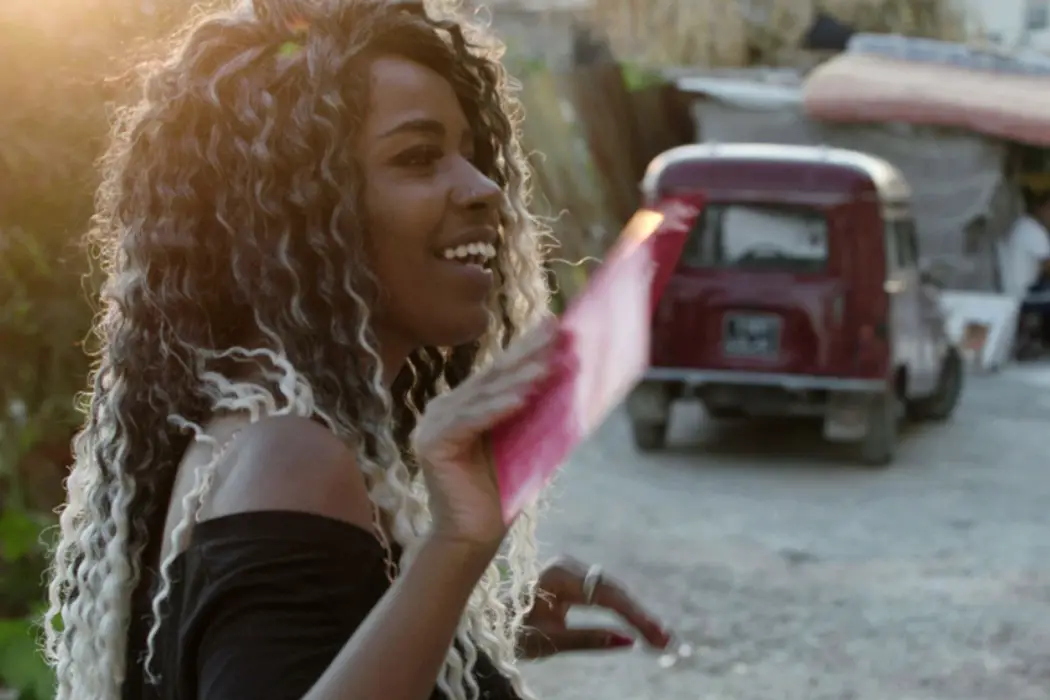
Musanna Ahmed is a freelance film critic writing for Film…
My final report of Amsterdam’s International Documentary Film Festival (IDFA) 2020 examines four more incredible films from around the world about a diverse series of subjects.
She Had a Dream (Raja Amari)
Bearing a title similar to that of MLK’s most famous speech, She Had a Dream is an inspiring story about how a woman turned pain into power.
Tunisian filmmaker Raja Amari, transitioning from narrative features to documentary, pays attention to the life of Ghofrane Binous, a 25-year-old activist who pursues her political aspiration by running for office during Tunisia’s 2019 national elections. All the odds are against Binous to succeed – Black, working-class, woman – something she realised so young when the kids at school would mock her for her skin colour. She hasn’t suffered discrimination in her own neighbourhood however she admits encountering casual prejudice by the privileged folks of Tunis. The sort of liberal racism that was highlighted in Get Out.
Amari’s film is a strong character study, studying her subject from an intimate vantage point. We learn about the activist’s family, beginning with a quick history lesson shared through a photo album, and even meet them in the city of Gabes as she goes for a visit. Their interaction is a familiar one: the child is passionate, the parents are nervous. It’s clear Binous is determined to succeed and the filmmaker mines suspense out of her campaign within the party of Prime Minister Youssef Chahed, who isn’t faring so well in his bid to be re-elected.
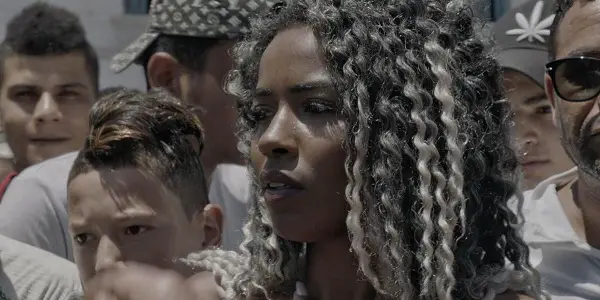
Like in many of the IDFA films I saw, She Had a Dream captures a contrast: an unheralded voice wants to break through in politics, but she works for an establishment candidate at a time when traditional parties are losing favour to outsiders. Chahed’s re-election bid failed, as the unorthodox final round saw a battle between a businessman and an academic. Binous’s role within Chahed’s team is quietly self-interrogated, as she struggles with the idea that she may have been selected for a good position within the party due to her identity.
The most admirable aspect of Amari’s approach to her intriguing subject is that she doesn’t focus on the incident that served as the catalyst for Binous’s political development. In 2018, Binous was working as a flight attendant and was subject to horribly racist abuse by a passenger, an incident that was recorded and led to the government adopting a law against racism. It would be almost fetishistic to focus on all the bad scenarios incidental to her skin colour – and there’s been a few, as we learn from Binous through voiceover narrations – and the filmmaker is instead interested in watching how Binous transforms the pain into power.
The narration offers highly detailed information and context into Binous’s life, if not the broader details of Tunisia’s political machinations. She shares memories, thoughts, and commentary on all aspects of her personal and political life, which very much are one and the same through no choice of her own. The camera stays by her face at almost all times, like we’re watching a László Nemes film. Effortlessly balancing the personal and the political – and the invisible line between them – the filmmaker offers a glimpse into the future of a better Tunisia through Binous’s unique odyssey.
Jacinta (Jessica Earnshaw)
Jacinta is a powerful film about the seemingly unbreakable cycle of addiction and trauma across three generations. From the vantage point of a close friend, Jessica Earnshaw’s documentary follows Jacinta, a 26-year-old mother whose life is a cycle of going in and out of prison. We can trace her habits to her mother Rosemary, who had Jacinta before she realised she could take on the responsibility of being a mother and who has seen the inside of a cell many times over the course of her life.
Jacinta herself was unprepared for the hardships of motherhood and gave birth to her daughter Caylynn at just 16-years-old. Products of their environment, Rosemary and Jacinta sought out hard drugs as an escape from their dreary mill town in Maine and have together spent a young child’s lifetime in and out of rehab and/or prison. Whilst it is an endlessly depressing watch, the interviews with Caylynn, a smart kid who recognises the destruction of her mother and grandmother’s habits, provide some hope for the future.
The extremely intimate style of filming essentially permits Earnshaw to use the most personal footage possible. Without warning, Jacinta plainly shoots up heroin on camera, a scene that really should come with sort of warning for the audience. She wears her heart on her sleeve when speaking to the camera, confessing how reliant she is on getting high and how she dearly loves her mother despite everything.
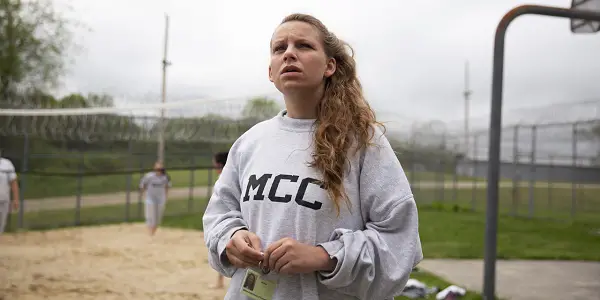
Earnshaw has the foresight to know that, if she really wants to understand Jacinta, she has to talk to close ones outside of the family too, and one friend shares an awful story about how Rosemary treated her daughter – something Jacinta wouldn’t dare to bring up because she loves her mother too much. One’s thoughts are provoked about the genesis of it all – is it the people around Jacinta, is it the wider heroin epidemic in America, is it the prison-industrial pipeline in working-class areas (I couldn’t help but consider how she may have had more chances at freedom than an equivalent Black individual), or all of the above?
Earnshaw isn’t an activist filmmaker who can tell us where to go and what to do to help in the fight against drug addiction but, by illuminating this sad story, she offers a frank view of what can happen where there are little resources to support recovering addicts outside of the relevant institutions. Even though I understand this was the filmmaker’s responsibility – perhaps no form of filmmaking humanises a subject more than observational documentary – I questioned if there was a point where the filmmaker should have intervened. Maybe the best moment in the film occurs in the late stages, when Jacinta is back in a treatment centre. She offers the filmmaker a reason to why she continued to participate in this documentary, and it’s bracingly selfless.
The Mole Agent (Maite Alberdi)
What a wonderfully moving film. Endearing and poignant in equal measure, Chilean director Maite Alberdi – who’s built a nice little filmography of documentaries focusing on the eccentricities of old folks – takes an outlandish premise and effortlessly extracts plenty of humour out of it, ultimately finding deep meanings when she least expects it. On paper, The Mole Agent sounds like a social experiment fit for a YouTube video at best – 83yo man Sergio goes undercover in an elderly care home to act as a mole agent for a private detective, who has been told by a client that her mother may be suffering under mistreatment in the residence.
But it unravels with such delicacy for its characters, observing Sergio in his element as the charming, wholesome man he is, easily making friends during his temporary stay, discussing family and eating meals together, and feeling stimulated in a way he hasn’t for a long time, as he describes to his nervous daughter. He even finds love and is crowned the king of the care home during one marvellous festivity.
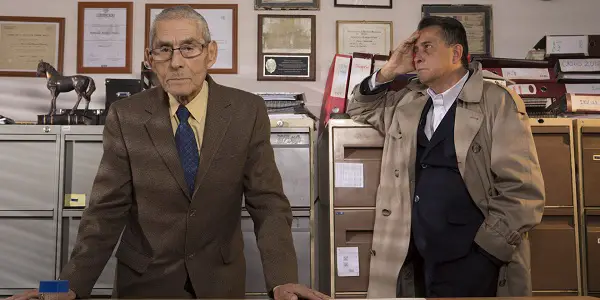
Parallel to this, he communicates with Romulo, the detective, who tasks him to find the client’s mother Sofia and discover what’s up. Sofia is thorny, refusing to entertain Sergio’s company, and it may be because he came up too strong, telling her she was very pretty and that he’d see her every day. Whilst he proves to be somewhat of a ladies’ man, this isn’t a lady that has an ounce of care for him. His spy tasks evolve over time, such as when the evidence piles up that there may be a thief in the home. Sergio uses recording specs for his undercover operation and there’s a sequence of him writing his thoughts in a journal and recording Whatsapp voice messages to Romulo that serves as a recurring motif in the film.
The James Bond-esque spy fun is carefully balanced with a deeper look at what it means to have family with you and the loneliness that can be encountered as an elderly person, even in an environment designed to provide care and support. Whilst Sergio may be living a pretend life in the care home, the emotional connections he makes to the place and people are very real. It’s an original perspective that is occassionally undermind by ethical issues, such as when Alberdi‘s camera is mistaken as a tool for spying – it’s something that makes the old people uncomfortable before they can even sniff out that Sergio has recording glasses on. But the emotional effect it ultimately achieves, and its success as both a moral tale and entertainment makes the entire experiment of The Mole Agent highly worthwhile. You’ll want to run up to your grandparents and hug them tight after this.
Showgirls of Pakistan (Saad Khan)
Showgirls of Pakistan is a really fascinating exposé of a subculture that feels like it exists between two worlds. Exactly what it says on the tin, Saad Khan’s documentary film follows three women who perform mujra, a dance performance that emerged during the Mughal empire, practised by courtesans for the elite classes of India. A private entertainment that is now subject to different restrictions depending on where you go.
One example is that each city dictates the length of the neckline that can be covered by a dancer. Ultimately, though, the basic premise teeters with illegality, potentially guilty under the law of vulgarity depending on the sort of performance. We learn that, in the crowd, a member of the arts council is always watching. There’s a fascinating contradiction in how the profession is shamed by many and considered immoral if not outright illegal, but we see in reaction shots just how much the full houses of crowds enjoy these shows, yelling at the stars with the energy of a concert crowd. Furthermore, slickly assembled montages of stars reacting to their fans in live social media videos further evidences their popularity.
By closing up on three women in their moments off stage, such as the backstage preparation and the phone calls with promoters and the daily lives at home, Khan captures a rich panorama of showgirls lobbying for stardom whilst battling with hostility and censorship. The filmmaker’s unorthodox approach chooses not to interweave the three stories to resemble a traditional three-act film and instead divide their arcs across each third of the film. The first character up is Afreen, a brutally honest entertainer who just doesn’t give a damn anymore about the haters. She’s established a career for herself and her candid anecdotes speak to a lifetime of hearing the same old criticism.
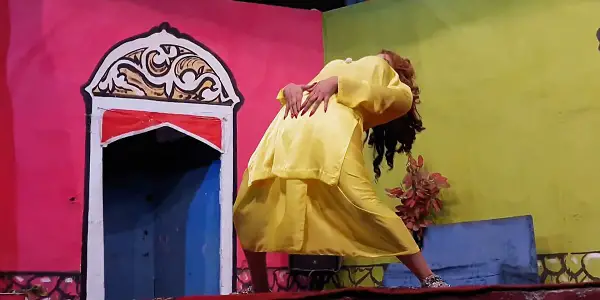
Then there’s the private dancer Uzma, who often goes abroad to places such as Dubai. She’s managed by her sleazy husband Imran, and the depiction of their wild saga is some of the most creative storytelling I’ve seen in recent times. It entails a whirlwind romance that escalates into mismanagement, suspicious dealings, and revenge, entirely told in audio logs and visually accompanied by a huge assortment of clips from Pakistani film and television that match the timeline of events. It’s a really brilliant sequence of synchronised archive and audio.
The third character is Reema, a successful stage actress and a khwaja sira, the community of gender non-conforming people in Pakistan. As with Uzma and Afreen, Reema is subject to the same sort of hypocrisy – prejudiced in public but enjoyed by the very same masses, selling out tickets to every show. Gender-based oppression and censorship permeate throughout their lives. Whatever you think of the dancers – whether they’re too provocative considering the cultural context, or are simply right to exercise their freedom of expression – this brilliantly constructed film puts a lens on the subculture without judgment, empathising with their often traumatic histories. Layers of danger are added when the women recall stories of contemporaries who have even been killed due to their profession.
Khan is a great visualist and establishes a great trust with his subjects, and demonstrates a good sense of theme to unify three disparate threads. However, his connection to the historical context of mujra is a little flimsy – we are told what it is, with a simple line on its class-based origins, but nobody talks about it, nobody is asked about it, and there are no other references to the historically significant dance in terms of either information or inspiration. It’s hard to draw a line between the dance as it originated and its current form. Otherwise, though, Showgirls of Pakistan is an invaluable document about this industry.
Does content like this matter to you?
Become a Member and support film journalism. Unlock access to all of Film Inquiry`s great articles. Join a community of like-minded readers who are passionate about cinema - get access to our private members Network, give back to independent filmmakers, and more.
Musanna Ahmed is a freelance film critic writing for Film Inquiry, The Movie Waffler and The Upcoming. His taste in film knows no boundaries.













